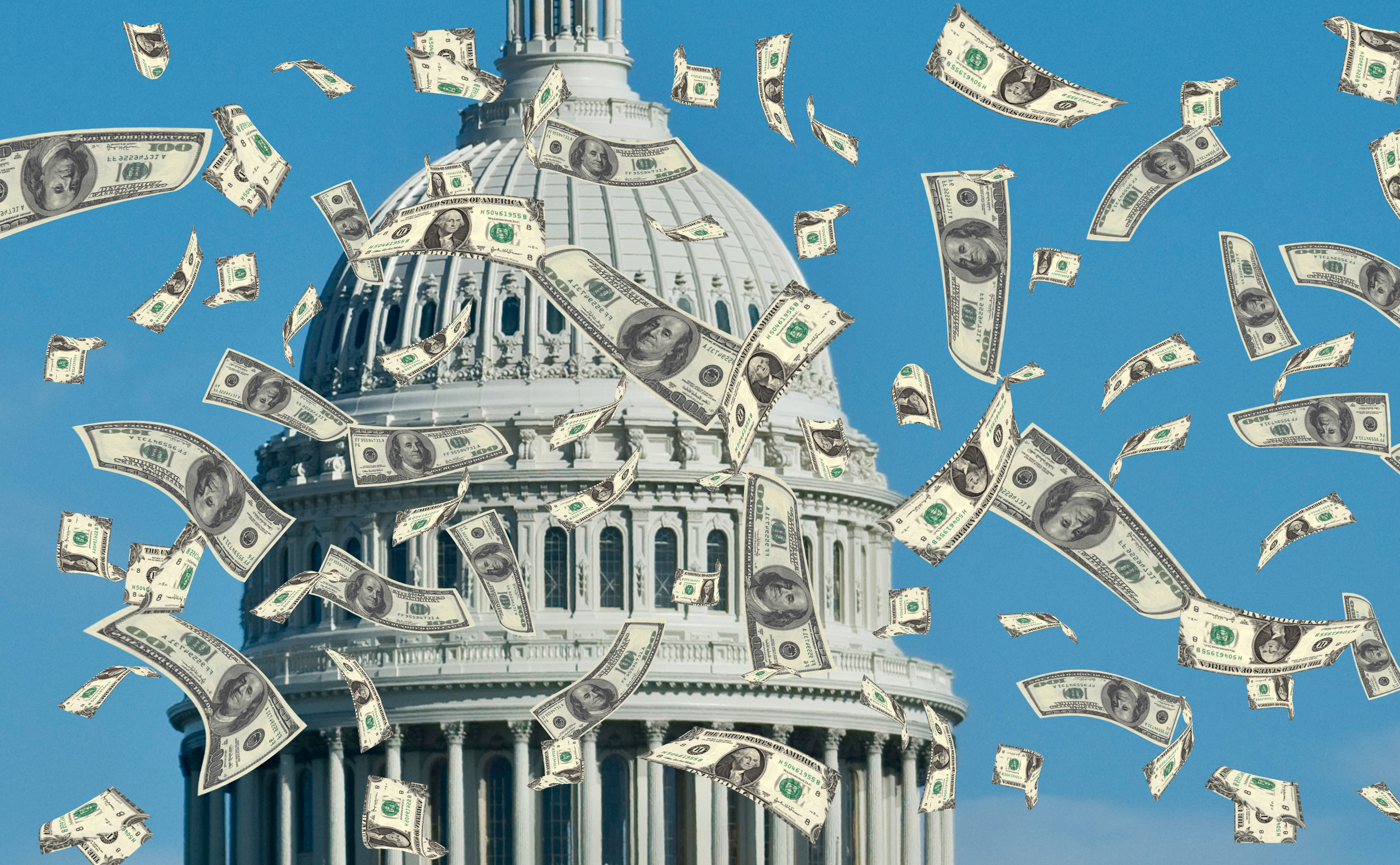Tax Deal: What's In It for You?
Your tax rates won’t go up next year and for most, a bigger paycheck.

American taxpayers can breathe a sigh of relief -- for now. After months of uncertainty, it’s now guaranteed that federal income-tax rates will remain at the same level for two more years. Most working Americans will see their paychecks increase in January thanks to a temporary reduction in payroll taxes, and the long-term unemployed can count on continued jobless benefits through 2011.
After a failed attempt to reshape the federal estate-tax provision that the Democratic leadership considered a giveaway to the wealthy, the House approved a massive tax package 277 to 148. The Senate approved an identical measure on Wednesday by an 81 to 19 margin.
The compromise package hammered out by the president and congressional Republicans has been hailed as a needed second stimulus to prevent the economy from slipping back into recession. But it comes at a steep price. The $850-billion agreement was crafted just weeks after a presidentially appointed bipartisan commission outlined recommendations for trimming $4 trillion from the yawning federal budget deficit over the next ten years and warned about the dire consequences if political leaders don’t reign in federal spending.
From just $107.88 $24.99 for Kiplinger Personal Finance
Become a smarter, better informed investor. Subscribe from just $107.88 $24.99, plus get up to 4 Special Issues

Sign up for Kiplinger’s Free Newsletters
Profit and prosper with the best of expert advice on investing, taxes, retirement, personal finance and more - straight to your e-mail.
Profit and prosper with the best of expert advice - straight to your e-mail.
In the long term, it is taxpayers who will pay the price in the form of inevitable future budget cuts, probable higher taxes, and possibly a reduced standard of living. But for now, Congress and the White House are sharing the role of Santa Claus, and Americans can’t wait to rip into their gifts.
Here’s a glimpse of what you can expect to unwrap over the next two years. (Batteries not included).
Stable rates on investment income
One of the biggest concerns among investors has been what would happen to tax rates on long-term capital gains and dividends if the Bush tax cuts were allowed to expire on December 31. Some had contemplated selling appreciated assets before the end of the year just to take advantage of current low capital-gains rates. Without congressional action, tax rates on the profits of assets sold after more than a year would have increased to 20%, and dividends would have reverted to being taxed at ordinary income rates as high as 39.6% starting in 2011. But now that it’s clear that tax rates will remain the same through 2012, it’s back to year-end tax planning as usual: defer income, such as bonuses, into next year when possible and accelerate deductions into the current year to minimize your taxable income.
Tax rates on long-term capital gains and qualified dividends will remain at a maximum 15% through 2012, and those in the two lowest income-tax brackets -- 10% and 15% -- will continue to enjoy a 0% capital-gains rate. So if you decide to rebalance your portfolio before the end of the year, follow your usual course of action: If sales and capital-gains distributions to date have produced a net gain, consider selling assets that will produce a loss to offset the profits . . . and the tax bill that goes along with them. If you wind up with net long-term gains, you’ll pay just 15% on your profits. If your losers outweigh your winners, you can use up to $3,000 of losses to offset ordinary income, such as wages, and carry over any excess losses to future years.
Bigger paychecks for most
One of the major elements of the tax package is a one-year reduction in the payroll tax that funds Social Security. FICA taxes will drop from 6.2% to 4.2% for most workers. Since the tax applies to up to $106,800 in 2011, the tax cut is worth as much as $2,136 for a worker or $4,272 for a working couple. (The self-employed will pay 10.4% on income up to the cap, down from 12.4% in 2010.) The 1.45% portion of payroll taxes that funds Medicare will continue to apply to all earnings with no cap.
But not everyone will benefit from the payroll-tax holiday. Workers who do not participate in the Social Security system, such as some public-school teachers and many civil servants, will see no reduction in their payroll taxes. And some federal employees will get hit with a double whammy: no break on payroll taxes and a wage freeze next year.
Some lower-income workers may also feel as if Santa left them a lump of coal in their stocking. Although they will benefit from the lower payroll tax, the tax break will not be as generous as the Making Work Pay credit that reduced their taxes by up to $400 for individuals and up to $800 for married couples in 2010 (subject to income limits).
For example, a married couple making $36,000 will see their payroll taxes reduced by $720 in 2011. Compared to the $800 Making Work Pay tax credit they enjoyed in 2010, their taxes would increase by $80 next year. But for an individual earning $36,000, that same $720 reduction in payroll taxes in 2011 will represent a $320 tax cut compared to the $400 tax credit he or she enjoyed in 2010.
In general, higher income taxpayers will benefit across the board from the payroll-tax reduction. For example, a married couple earning $75,000 per year will pay $1,500 less in payroll taxes in 2011, nearly twice the size of the $800 tax credit they benefitted from in 2010. And a couple earning $150,000, who were not eligible for the Making Work Pay credit this year, will see their Social Security payroll taxes decline by the maximum $2,136 in 2011.
No cap on exemptions, deductions
Upper-income taxpayers will also benefit from no limit on their itemized deductions and the personal exemptions that they claim for themselves, their spouse and dependents. In the past, those tax benefits were reduced above certain income levels. Caps on both deductions and personal exemptions were eliminated for 2010, and the legislative package extends those valuable tax breaks through 2012.
Middle class dodge the AMT
The compromise tax package boosts the exemption levels for the alternative minimum tax, protecting more than 20 million middle-income taxpayers from being snagged by the parallel tax system that disallows most tax deductions and exemptions. The AMT, designed 40 years ago to ensure that the loophole-savvy wealthy paid at least some taxes, has never been indexed for inflation. So over the decades, the AMT has morphed from a class tax into a mass tax, prompting Congress to approve temporary patches each year to lift the AMT exemption level and spare millions of middle-class taxpayers from becoming unintended victims of the stealth tax. The package increases the AMT exemption levels for 2010 and 2011.
More breaks for education costs
The popular American Opportunity tax credit, worth up to $2,500 to offset the high cost of college, was scheduled to expire at the end of 2010. Now it has been extended through 2012. The full credit, which reduces your tax bill dollar-for-dollar, is available to individuals with incomes of up to $80,000 and married couples with joint income of up to $160,000. The credit phases out above those income levels, disappearing at $90,000 for individuals and $180,000 for married couples.
The tax package also extends more-generous contribution levels and qualified tax-free distributions for Coverdell Education Savings Accounts, which can be used to fund elementary- and secondary-school expenses in addition to college costs. Maximum contribution levels had been slated to drop from $2,000 to $500 per year beginning in 2011, and tax-free distribution would have been limited to college expenses. The package extends existing funding and distribution rules through 2012.
Two-year reprieves
A host of other popular tax breaks that had expired at the end of 2009 have been reinstated for 2010 and 2011. You’ll appreciate them when you file your taxes next spring. They include:
-- a choice between deducting state sales taxes or state income taxes;
-- a tax deduction of up to $4,000 for college tuition costs available to some taxpayers whose incomes are too high to qualify for the American Opportunity credit;
-- a deduction of up to $250 that teachers can claim for our-of-pocket expenses for classroom supplies, even if they don’t itemize their deductions;
-- and the ability of taxpayers who are age 70½ or older to donate up to $100,000 of their IRAs directly to a charity and exclude the amount of their donation from their taxable income.
More-generous estate tax
The most controversial element of the tax package is a reinstatement of the federal estate tax, which had temporarily disappeared in 2010, with a higher exemption level and a lower rate than in the past. Beginning in 2011, estates valued at $5 million or less ($10 million or less for married couples) will escape the federal estate tax completely, and estates above those thresholds would be taxed at a 35% rate. House Democrats, who had been excluded from negotiations on the package, railed against the deal, which they claimed is a giveaway to the rich. But in the end, they failed in efforts to ratchet down the exemption to the $3.5 million level that had been in effect in 2009 before the estate tax expired and to increase the tax rate to 45%.
Profit and prosper with the best of Kiplinger's advice on investing, taxes, retirement, personal finance and much more. Delivered daily. Enter your email in the box and click Sign Me Up.

-
 Your Guide to Buying Art Online
Your Guide to Buying Art OnlineFrom virtual galleries to social media platforms, the internet offers plenty of places to shop for paintings, sculptures and other artwork without breaking the bank.
-
 Samsung Galaxy S25 Ultra for $4.99 a Month: A Closer Look at Verizon’s Deal
Samsung Galaxy S25 Ultra for $4.99 a Month: A Closer Look at Verizon’s DealVerizon’s aggressive pricing makes Samsung’s top-tier phone tempting, but the real cost depends on your plan and how long you stay.
-
 I'm 59 with $1.7 million saved and lost my job. Should I retire?
I'm 59 with $1.7 million saved and lost my job. Should I retire?We asked professional wealth planners for advice.
-
 Retirees in These 7 States Could Pay Less Property Taxes Next Year
Retirees in These 7 States Could Pay Less Property Taxes Next YearState Taxes Retirement property tax bills could be up to 65% cheaper for some older adults in 2026. Do you qualify?
-
 Estate Tax Quiz: Can You Pass the Test on the 40% Federal Rate?
Estate Tax Quiz: Can You Pass the Test on the 40% Federal Rate?Quiz How well do you know the new 2026 IRS rules for wealth transfer and the specific tax brackets that affect your heirs? Let's find out!
-
 5 Types of Gifts the IRS Won’t Tax: Even If They’re Big
5 Types of Gifts the IRS Won’t Tax: Even If They’re BigGift Tax Several categories of gifts don’t count toward annual gift tax limits. Here's what you need to know.
-
 The 'Scrooge' Strategy: How to Turn Your Old Junk Into a Tax Deduction
The 'Scrooge' Strategy: How to Turn Your Old Junk Into a Tax DeductionTax Deductions We break down the IRS rules for non-cash charitable contributions. Plus, here's a handy checklist before you donate to charity this year.
-
 Tax Refund Alert: House GOP Predicts 'Average' $1,000 Payouts in 2026
Tax Refund Alert: House GOP Predicts 'Average' $1,000 Payouts in 2026Tax Refunds Here's how the IRS tax refund outlook for 2026 is changing and what steps you can take now to prepare.
-
 New IRS Changes to FSA Contribution Limits for 2026: What to Know
New IRS Changes to FSA Contribution Limits for 2026: What to KnowHealth Care Flexible Spending Accounts have tax advantages worth looking into, especially in light of new IRS changes.
-
 Is a New $25,000 Health Care Tax Deduction Coming in 2026?
Is a New $25,000 Health Care Tax Deduction Coming in 2026?Tax Policy A proposal from GOP Sen. Josh Hawley adds to the chatter about health care affordability.
-
 Are You Middle-Class? Here's the Most Tax-Friendly State for Your Family
Are You Middle-Class? Here's the Most Tax-Friendly State for Your FamilyTax Tips We found the state with no income tax, low property tax bills and exemptions on groceries and medicine.